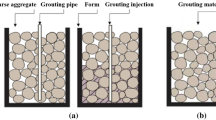Abstract
The influence of coarse aggregate content on concrete properties was investigated. From the perspective of Frame Concrete Theory, six groups concrete were produced with the same proportion except for coarse aggregate content, with coarse aggregate content of 0%, 40%, 50%, 60%, 75%, and 80%, respectively. Slump, compressive and flexural tensile strengths, elastic modulus, and water penetration were tested to research the effect of coarse aggregate content on concrete. The experimental results reveal that slump reduces with increasing of coarse aggregate content, while compressive strength, elastic modulus and flexural tensile strength increase with the coarse aggregate content increasing, and water penetration reduces with coarse aggregate content increasing before 75% then increased. Workability, strength, durability and economical indexes system were established to optimize the coarse aggregate content in concrete based on efficacy coefficient method. The optimization results show that when coarse aggregate content is 60%, the system efficacy coefficient reaches to 0.89, and it expresses the better comprehensive performance.
Similar content being viewed by others
References
Maslehuddin M, M Sharif Alfarabi, Shameem M, et al. Comparison of Properties of Steel Slag and Crushed Limestone Aggregate Concretes[J]. Construction and Building Materials, 2003, (17): 105–112
Wang L J. Building Materials[M]. Beijing: China Water-Power Press, 2008: 1–5
Wang L J, Wang Z S, Meng D. Study on Concrete Framework Model on Mortar Ratio Deviation[C]. In: Li Jie, Wu Bo, Wu Zhishen, Wang Zhan, et al. Innovation and Sustainability of Structures Proceedings of the International Symposium on Innovation and Sustainability of Structures in Civil Engineering. Guangzhou: South China University of Technology Press, 2009: 77–82
Kumar Mehta P, Paulo J M Monteiro. Concrete Microstructure, Properties, and Materials[M]. The McGraw-Hill Companies, lnc, 2006: 165–170
Mohammed Seddik Meddah, Salim Zitouni, Said Belaabe. Effect of Content and Particle Size Distribution of Coarse Aggregate on the Compressive Strength of Concrete[J]. Construction and Building Materials, 2009, (10): 1–8
Sengul O, Tasdemir C, Tasdemir MA. Influence of Aggregate Type on Mechanical Behavior of Normal and High-strength Concretes[J]. ACI Materials Journal, 2002, 99(6): 528–533
Goble CF, Cohen MD. Influence of Aggregate Surface Area on Mechanical Properties of Mortar[J]. ACI Materials Journal, 1999, 96(6): 657–662
Neville AM, Brooks J. Concrete Technology[M]. England: Longman, 1993: 78–82
Aitcin PC, Mehta PK. Effect of coarse Aggregate Characteristics on Mechanical Properties of High-strength Concrete[J]. ACI Materials Journal, 1990, 87(2): 103–107
Cetin A, Carrasquillo RL. High-performance Concrete: Influence of Coarse Aggregates on Mechanical Properties[J]. ACI Materials Journal, 1998(3): 252–261
Zhou FP, Lydon FD, Barr BIG. Effect of Coarse Aggregate on Elastic Modulus and Compressive Strength of High-strength Concrete[J]. Cement and Concrete Research, 1995, 25(1): 177–186
Stock AF, Hannant DJ, Williams RIT. The Effect of Aggregate Concentration upon the Strength and Modulus of Elasticity of Concrete[J]. Cement and Concrete Research, 1979(109): 225–234
Yang S Q, Gao W S. Harmony Coefficient and Regional Agricultural Systems[J]. Agricultural Science in China, 2006, 5(7): 539–544
Zhan B J, Shui Z H, Chen W, et al. Mix Optimization of High Performance Concrete based on Efficacy Coefficient Method[J]. Journal of Wuhan University of Technology, 2009, 4: 29–32
ACI 318-M 95. Buliding Code Requirements for Structural Concrete and Commentary[S].
Ge Y, Kong L J, Zhang B S, et al. Effect of Lightweight Aggregate Pre-wetting on Microstructure and Permeability of Mix Aggregate Concrete[J]. Journal of Wuhan University of Technology-Materials Science Edition, 2009, 24(5): 838–842
Lampacher EJ, Blight GE. Permeability and Sorption Properties of Mature Near-surface Concrete[J]. Journal of Material Civil Engineering, 1998, 10(1): 21–25
Bretton D, Oliver J P and Ballivy G. Diffusivity of Chloride Ions in the Transition Zone Between Cement Paste and Granite Interfaces[C]. In: Proceedings 18 of the RILEM International Conference E&FN Spon, London, 1992: 269–278
Zhao T J. Concrete Permeability[M]. Beijing: Science Press, 2006: 48–49
Author information
Authors and Affiliations
Corresponding author
Additional information
Funded by the National Mega-project of Scientific & Technical Supporting Programs, Ministry of Science & Technology of China( No.2006BAJ04A 04), and the Education Department of Liaoning Province, China(No. 2008282)
Rights and permissions
About this article
Cite this article
Wang, Z., Wang, L., Su, H. et al. Optimization of coarse aggregate content based on efficacy coefficient method. J. Wuhan Univ. Technol.-Mat. Sci. Edit. 26, 329–334 (2011). https://doi.org/10.1007/s11595-011-0224-2
Received:
Accepted:
Published:
Issue Date:
DOI: https://doi.org/10.1007/s11595-011-0224-2




